Finally back in Tokyo. Flights all on time, landed early at 7.30am on a Friday; only problem was that Customs decided to search everything, don’t know why this knackered looking tourist got pulled. Mind you, he was a very nice Customs official and carefully repacked my rucksack. They could teach Saudi Customs a thing or two, you have to chase your underwear up the moving carousel as they chuck it on!
Eventually got the train into Tokyo, though I fell asleep at some point and only woke up when it was just departing for its return trip to the airport! Using my faithful GPS, more of this later, I soon found my Ryokan, a very nice place, complete with tatami mat with nice futon and kettle with tea just 15 mins walk away from Ueno Station. I dumped my bag and followed the sound of drums to the Nezu temple, just in time for Taiko drumming and a big parade – well that kept me awake and the jet-lag at bay!
Had a wander in the park and found a supermarket so I won’t starve. It’s over 80 degrees and sunny now, early May. I met up with my Japanese friend Hanae one evening, and we had a wander round Ueno market. She showed me stuff I wouldn’t have had a clue about, such as whole legs of octopus for example. We went to a local coffee shop for a long chat and catch up. My friend’s husband is a travel writer, and was not able to join us because he was in PNG!
Then I took the train to Kamakura, a very nice place, though by 2pm, jet-lag was catching up on me. Kamakura is on a peninsula south of Tokyo and Yokohama.
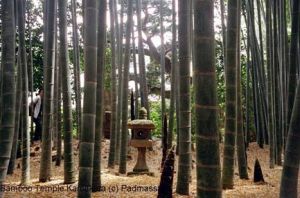 In Kamakura, I visited the Bamboo temple that my Tokyo friend told me about, set in a grove of bamboo, with monks chanting and green tea served in the garden. After this, I visited the giant Buddha, which used to be in a building until a tsunami removed them.
In Kamakura, I visited the Bamboo temple that my Tokyo friend told me about, set in a grove of bamboo, with monks chanting and green tea served in the garden. After this, I visited the giant Buddha, which used to be in a building until a tsunami removed them.
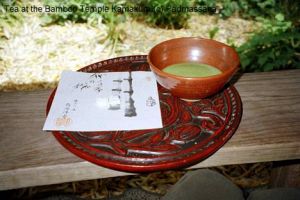 From Kamakura, I went to Enoshima island which is near Kamakura. It takes about an hour on the train from Tokyo. Enoshima was fun and tried to do a geocache, but there were too many people about and too much rubbish around as well, so went back to Tokyo.
From Kamakura, I went to Enoshima island which is near Kamakura. It takes about an hour on the train from Tokyo. Enoshima was fun and tried to do a geocache, but there were too many people about and too much rubbish around as well, so went back to Tokyo.
For my next trip, I took the train from Tokyo to Yamagata which takes about 3 hours including train hopping at Fukushima. To do this, I took the Shinkansen (Bullet train), super quick up to Fukushima where the train split in half. Needless to say, I was in the wrong half that was heading for Sendai so I had to get off and leg it onto the half continuing on to Yamadera, phew!!!
Yamadera is a lovely place, very friendly and the ryokan was only 4400 yen/night (about £20.). Went for wander to the castle and had a picnic in the park, found some of my favourite “Pea crips” in Daiei (Giant department store with good food place underneath) yum. I love looking round the “100 Yen shop”, they have all kinds of stuff in them. I went round a supermarket and saw “Wanko noodles” – I gave them a miss.
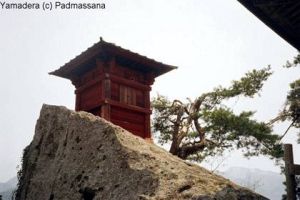 Another trip I made was taking the bus to Mt Zao, which despite being only 10 miles away took 90 mins to get to, thanks to the winding mountain roads and switchback hairpins. It was worth the ride to see Okama, a massive volcanic lake, fantastic place, you get to it via a chair lift. Loads of snow still, which you have to slip and slide through. Then walked up to Mt Kattadate over 5,000ft, spectacular views. Bought a mini bell for my rucksack. The Japanese all have them, they are to scare off bears!
Another trip I made was taking the bus to Mt Zao, which despite being only 10 miles away took 90 mins to get to, thanks to the winding mountain roads and switchback hairpins. It was worth the ride to see Okama, a massive volcanic lake, fantastic place, you get to it via a chair lift. Loads of snow still, which you have to slip and slide through. Then walked up to Mt Kattadate over 5,000ft, spectacular views. Bought a mini bell for my rucksack. The Japanese all have them, they are to scare off bears!
Then went to Yamadera to visit Basho, a place with little temples up a hill, it looks lovely in the guidebook. Yamadera is very touristy and should be known as Basho theme park. There are lovely temples up a mountain, over 1000 steps to the top, but what a view. Went to the Basho museum which has some of his calligraphy, quite interesting, but little in English.
Went to Tendo, a place is famous for making Shogi pieces for Japanese chess, quite an interesting museum and they gave me a nice book with it all in English.
Then visited Sendai primarily to visit Matsushima. Matsushima itself far too expensive to stay in, but with my rail pass an easy hit for daytrips from Sendai, also hope to do geocache in Sendai. I booked all of my accommodation on my trip on the internet as I went along.
Arrived in Sendai with a stinking cold and started looking for Ryokan Iwai, but got a bit lost in the vicinity when a little old lady asked me what I was looking for, luckily she used to work there and literally lead me by the hand and pointed it out across the street and insisted I wait for the green man at the crossing!
Went out to explore Sendai, a very big busy place that has a kfc! Tried to do a geocache in the suburbs, found a huge black snake on the path, but thanks to my Bear scaring bell it went away.
I had a major experience at the Sumitomo bank to change some Yen travellers cheques, what a palaver. The teller eventually gave me a form in Japanese for me to fill in, um yeah, right! So she then pointed at each square and wrote on a bit of paper what I had to write in each box! Why she couldn’t just fill it in and get me to sign it?
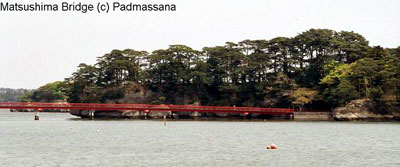 Eventually got the train to Hon Shiogama, this was in order to take the scenic boat trip to Matsushima (1400Yen). Nice 50 min ride through all the little islands, though absolutely freezing there and very windy.
Eventually got the train to Hon Shiogama, this was in order to take the scenic boat trip to Matsushima (1400Yen). Nice 50 min ride through all the little islands, though absolutely freezing there and very windy.
Eventually got to Matsushima and explored the big temple, but not fun in the driving rain. Then decided to head north to Morioka after talking to a Kiwi couple. Sado-ga Island would have been nice to visit, but with only local trains crossing Honshu this would mean 2 days of travelling, I get better value for my rail pass to go to Morioka, and from there I can go to Miyako on the coast and Kakunodate Samurai houses from there.
Most of my Ryokan arrivals have both been done via my knowledge of numbers 1 to 5 in Japanese and sleep mime signs! They bring out calculator and show me the price. Apart from a Kiwi couple, I have not seen a non Japanese person, unlike Tokyo, where there are lots of foreigners. That said, everyone without exception is helpful and friendly, things may take time like the bank, but I get there in the end.
This trip I have tried to move less, i.e. pick places where I can stay but can get to other places, such as Yamagata which was great for Zao and Yamadera as well as Yamagata itself. Sendai was perfect for Matsushima and from Morioka I can hit Miyako, Kokonodate, Mt Iwata and then back to Tokyo. I really want to see Mt Fuji this time, just got to pray for a clear day.
The sun shone the day I made it to Morioka from Sendai to Morioka on the bullet train. They go so fast you can’t read station names of places you pass and it’s too fast for GPS as well, I tried it! They are very quiet though.
I love travelling alone, you get to talk to more people even if it is through sign language. However just had a nice chat in English with Tourist office, think the girl enjoyed using her English. She told me to visit Miyako on the coast and Hirazumi for its temples. However Mt Iwata volcano still has 5 metres of snow so that one is out, she reckons the walking paths up there will not be open until end June or July.
When I left my Morioka Ryokan, all the people came to say goodbye and bowed as I left (I’m not worthy!) and gave me a little towel as a present for staying. Those are the things I li
ke a
bout Japan its efficiency and its friendliness.
Japanese geocaches either have proper Japanese translation underneath or the Japanese written in English letters. When you look at the logs for the caches some are in Japanese and some in English.

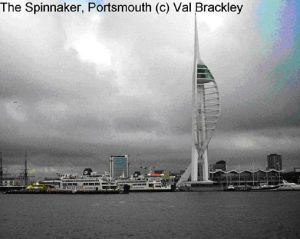 which has been restored to 1860’s condition and the Mary Rose Museum, which is the only 16th century warship on display in the world. It was built for Henry VIIII and sank in 1545. There are also interesting harbour cruises available.
which has been restored to 1860’s condition and the Mary Rose Museum, which is the only 16th century warship on display in the world. It was built for Henry VIIII and sank in 1545. There are also interesting harbour cruises available.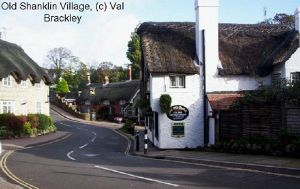
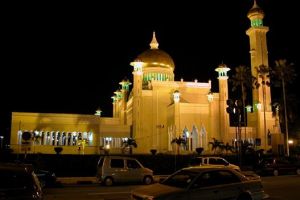 Public transport, or rather the lack of it lets Brunei down. There are buses, but the network is not extensive and they tend to stop at 5pm, so hiring a car is something of a pre-requisite.
Public transport, or rather the lack of it lets Brunei down. There are buses, but the network is not extensive and they tend to stop at 5pm, so hiring a car is something of a pre-requisite.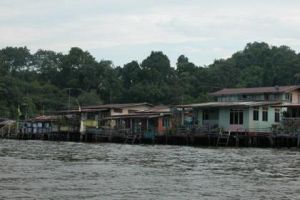 by a boatman who lives there that around 20,000 people live in the Kampong and more and more are leaving for more comfortable housing. I say up market, because it has electricity, satellite dishes and some of the houses have two storeys and pretty painted verandas and large
by a boatman who lives there that around 20,000 people live in the Kampong and more and more are leaving for more comfortable housing. I say up market, because it has electricity, satellite dishes and some of the houses have two storeys and pretty painted verandas and large 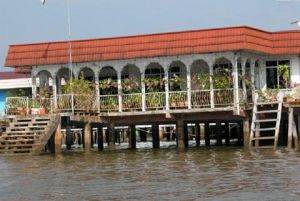 pots of flowers and other plants. There are also several primary and secondary schools, a mosque and a fire station and a floating Shell petrol station. On my last trip there, I was told that the govt has plans to demolish some of the houses to build a bridge but it is still in the planning stage and attracting much controversy. The inhabitants are planned to be moved to the less characterful single storey concrete houses on stills at the lower end of the Kampong. It’s a little strange to see people’s cars parked on the opposite side of
pots of flowers and other plants. There are also several primary and secondary schools, a mosque and a fire station and a floating Shell petrol station. On my last trip there, I was told that the govt has plans to demolish some of the houses to build a bridge but it is still in the planning stage and attracting much controversy. The inhabitants are planned to be moved to the less characterful single storey concrete houses on stills at the lower end of the Kampong. It’s a little strange to see people’s cars parked on the opposite side of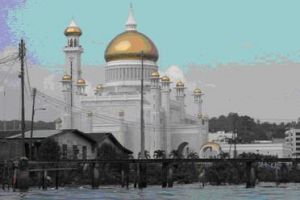 the Kampong – there are loads, and another reason why I say it’s not quite like similar Kampong’s I’ve seen. You should expect to pay about between 15 – 20 Brunei dollars for an hour’s tour of the Kampong. Further upstream you can see proboscis monkeys in the morning and late afternoon, but the usual boatmen will not usually take you there, you may find you have to book a tour (not cheap at 60 Brunei dollars).
the Kampong – there are loads, and another reason why I say it’s not quite like similar Kampong’s I’ve seen. You should expect to pay about between 15 – 20 Brunei dollars for an hour’s tour of the Kampong. Further upstream you can see proboscis monkeys in the morning and late afternoon, but the usual boatmen will not usually take you there, you may find you have to book a tour (not cheap at 60 Brunei dollars).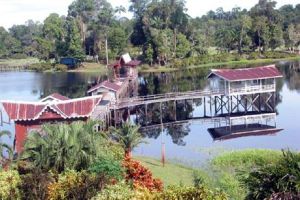 Tasek Merimbun, also known as Merimbun Heritage Park, is 27km (17miles) inland from Tutong, and contains Brunei’s largest lake with a tumbled down and decidedly precarious wooden walkway that used to take you all the way out over the lake and across to the island in the middle. It used to be a pretty place surrounded by forest with several walking trails. You can tell that it used to be very pretty but it has a somewhat dilapidated air about it these days.
Tasek Merimbun, also known as Merimbun Heritage Park, is 27km (17miles) inland from Tutong, and contains Brunei’s largest lake with a tumbled down and decidedly precarious wooden walkway that used to take you all the way out over the lake and across to the island in the middle. It used to be a pretty place surrounded by forest with several walking trails. You can tell that it used to be very pretty but it has a somewhat dilapidated air about it these days. 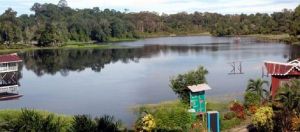
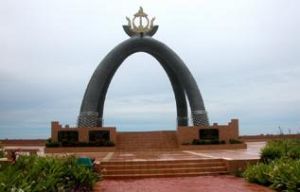 It commemorates the production of billionth barrel of oil by the Seria oilfield which can be seen very close to the shore.
It commemorates the production of billionth barrel of oil by the Seria oilfield which can be seen very close to the shore. 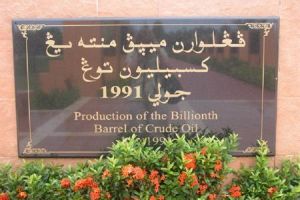 expats, it was around this time that various foreign workers responsible for maintaining the amusement ground left the country, so some local people laughingly joke that the rides are not quite as safe as they once were. When the Beetle went, most rides were available and she had great fun on the large roller coaster (there are two or three) and especially the log flume which does a crazy reverse at the top of a peak and whooshes down backwards (amidst much embarrassing Beetle squeaks). The
expats, it was around this time that various foreign workers responsible for maintaining the amusement ground left the country, so some local people laughingly joke that the rides are not quite as safe as they once were. When the Beetle went, most rides were available and she had great fun on the large roller coaster (there are two or three) and especially the log flume which does a crazy reverse at the top of a peak and whooshes down backwards (amidst much embarrassing Beetle squeaks). The 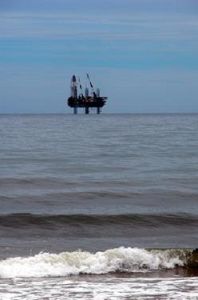 second time the Beetle visited, many rides were shut down for maintenance, but it’s still a fun and occasionally spooky place to visit (where there is no lighting because the rides are closed) for an evening out. Now many rides languish, waiting for spare parts or to be re-insured but it’s still an intriguing experience to wander round
the massive semi-deserted grounds in the evening.
second time the Beetle visited, many rides were shut down for maintenance, but it’s still a fun and occasionally spooky place to visit (where there is no lighting because the rides are closed) for an evening out. Now many rides languish, waiting for spare parts or to be re-insured but it’s still an intriguing experience to wander round
the massive semi-deserted grounds in the evening.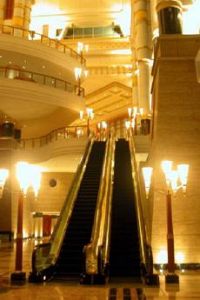 commissioned by the Sultan’s brother, Prince Jefri. This amazingly luxurious
commissioned by the Sultan’s brother, Prince Jefri. This amazingly luxurious 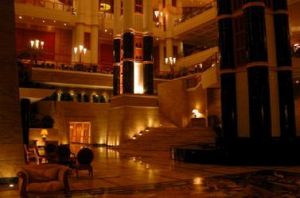 Empire Hotel which inside resembles a pastiche of all the different styles you possibly imagine, from 1920s art deco to the Harrods-like Egyptian and Greek columns is very impressive and a tourist sight in its own right – an absolute must in all its gaudy glory. There are several restaurants and buffets to sample and there is a small beach and pools as part of the grounds. Definitely worth a visit and occasionally, because of very low occupancy rates, good rates are to be had to stay in the hotel.
Empire Hotel which inside resembles a pastiche of all the different styles you possibly imagine, from 1920s art deco to the Harrods-like Egyptian and Greek columns is very impressive and a tourist sight in its own right – an absolute must in all its gaudy glory. There are several restaurants and buffets to sample and there is a small beach and pools as part of the grounds. Definitely worth a visit and occasionally, because of very low occupancy rates, good rates are to be had to stay in the hotel.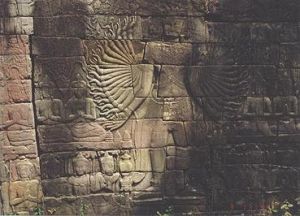 Never fully excavated and inaccessible for decades due to Khmer Rouge activity in the area, Banteay Chhmar (“Narrow Fortress”) was constructed late in the 12th century, allegedly as the funerary temple of King Jayarvarman VII’s son, the Crown Prince Indravarman and four generals killed in the war against the Chams. Other scholars have suggested it was built following the death of Rajapatindralakshmi, the paternal grandmother of the King. Along with its ruined face-towers, the temple is renowned for its bas-reliefs, which cover the outer face of the enclosing gallery and includes a unique sequence of multi-armed Lokitesvaras (left).
Never fully excavated and inaccessible for decades due to Khmer Rouge activity in the area, Banteay Chhmar (“Narrow Fortress”) was constructed late in the 12th century, allegedly as the funerary temple of King Jayarvarman VII’s son, the Crown Prince Indravarman and four generals killed in the war against the Chams. Other scholars have suggested it was built following the death of Rajapatindralakshmi, the paternal grandmother of the King. Along with its ruined face-towers, the temple is renowned for its bas-reliefs, which cover the outer face of the enclosing gallery and includes a unique sequence of multi-armed Lokitesvaras (left).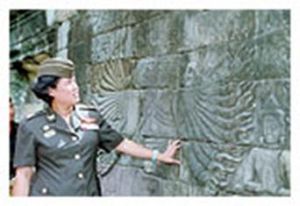 Unfortunately these carvings have been an irresistible magnet for looters in the last few years and this pillage plumbed new depths recently with the boldest and best-organised temple robbery of all time. In all, just under half of the temple’s wall carvings have now been removed but the latest theft was discovered by accident when Thai police stopped a truck carrying no less than 117 heavy stone pieces from a dismantled wall. This has prompted a major crackdown on the plundering of artefacts from the 1,200 ancient temples scattered across the country by both Cambodian and Thai authorities. A visit by Thai Princess Maha Chakri Sirindhorn to Banteay Chhmar has helped to raise awareness of the plight facing these remote Khmer temples and the above picture shows her inspecting one of the bas-reliefs still in place.
Unfortunately these carvings have been an irresistible magnet for looters in the last few years and this pillage plumbed new depths recently with the boldest and best-organised temple robbery of all time. In all, just under half of the temple’s wall carvings have now been removed but the latest theft was discovered by accident when Thai police stopped a truck carrying no less than 117 heavy stone pieces from a dismantled wall. This has prompted a major crackdown on the plundering of artefacts from the 1,200 ancient temples scattered across the country by both Cambodian and Thai authorities. A visit by Thai Princess Maha Chakri Sirindhorn to Banteay Chhmar has helped to raise awareness of the plight facing these remote Khmer temples and the above picture shows her inspecting one of the bas-reliefs still in place. 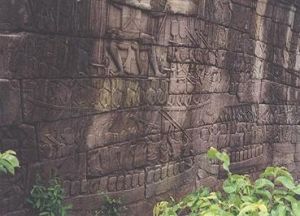 Banteay Chhmar originally covered an area of 2.5 x 2km (in comparison, Angkor Thom is 3km square) and contained the main sandstone temple, a number of other religious structures and a baray (1500 x 700m) to the east of the temple. Lying outside the moat-enclosed main temple’s eastern entrance is an isolated stone rest-house, known as a dharmasala (similar to the one found at Preah Khan in Angkor). A wall measuring 250 x 190 metres surrounds the temple proper, with four gopuras in the middle of each side. Its outer face carries bas-reliefs on three tiers showing alternating military and religious scenes, recalling those of the outer gallery of the Bayon, including battle scenes featuring the Chams (left). Although some parts of the wall have collapsed, the best of the reliefs are south of the gopura on the west wall and include a series of eight colossal standing, multi-armed Lokitesvaras, facing west.
Banteay Chhmar originally covered an area of 2.5 x 2km (in comparison, Angkor Thom is 3km square) and contained the main sandstone temple, a number of other religious structures and a baray (1500 x 700m) to the east of the temple. Lying outside the moat-enclosed main temple’s eastern entrance is an isolated stone rest-house, known as a dharmasala (similar to the one found at Preah Khan in Angkor). A wall measuring 250 x 190 metres surrounds the temple proper, with four gopuras in the middle of each side. Its outer face carries bas-reliefs on three tiers showing alternating military and religious scenes, recalling those of the outer gallery of the Bayon, including battle scenes featuring the Chams (left). Although some parts of the wall have collapsed, the best of the reliefs are south of the gopura on the west wall and include a series of eight colossal standing, multi-armed Lokitesvaras, facing west.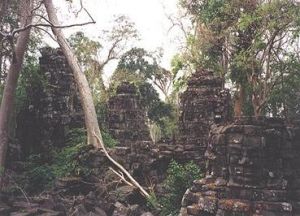 The confusing jumble of ruins that comprises the temple’s central complex gives the visitor no obvious route or path to follow and due to the tangled vegetation the best way of exploring is scrambling over gallery roofs and the large piles of collapsed stones. The long, narrow central sanctuary (170 x 40m) has interconnected galleries, gopuras and towers, both with and without carved faces (again, similar in style to those at the Bayon; pictured right). Near the centre, three face-towers stand in isolation amongst the ruins and undergrowth. To the north, west and south are three separate temples with more faces but most have collapsed and cannot be identified. Close by, a building known as the ‘Hall of Dancers’ houses a fine lintel showing half-human, half-bird apsaras, rishis and Brahma in excellent condition.
The confusing jumble of ruins that comprises the temple’s central complex gives the visitor no obvious route or path to follow and due to the tangled vegetation the best way of exploring is scrambling over gallery roofs and the large piles of collapsed stones. The long, narrow central sanctuary (170 x 40m) has interconnected galleries, gopuras and towers, both with and without carved faces (again, similar in style to those at the Bayon; pictured right). Near the centre, three face-towers stand in isolation amongst the ruins and undergrowth. To the north, west and south are three separate temples with more faces but most have collapsed and cannot be identified. Close by, a building known as the ‘Hall of Dancers’ houses a fine lintel showing half-human, half-bird apsaras, rishis and Brahma in excellent condition.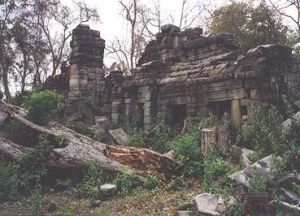 The temple complex lies sixty kilometres north of Sisophon along Route 69 and just thirteen kilometres from the Thai border. From Sisophon, it takes around 2 hours on a motorbike to travel the 43 kilometres to the village of Thmar Puok and then another seventeen kilometres to the south-west corner of the moat surrounding Banteay Chhmar. The road follows the moat around to the east side and a broad causeway, flanked by the baray, signals the entrance to the temple-city. Foreign visitors have so far been few and far between, although the improved security situation in the area will one day make the temple a popular diversion for those taking the overland route from Thailand into Cambodia via Poipet. A recent [2000] visitor to the site, Phalla from Angkor Adventures, confirmed that soldiers act as guides for the few travellers that make it up there and charge a $5 entrance fee. He took the pictures that you see above.
The temple complex lies sixty kilometres north of Sisophon along Route 69 and just thirteen kilometres from the Thai border. From Sisophon, it takes around 2 hours on a motorbike to travel the 43 kilometres to the village of Thmar Puok and then another seventeen kilometres to the south-west corner of the moat surrounding Banteay Chhmar. The road follows the moat around to the east side and a broad causeway, flanked by the baray, signals the entrance to the temple-city. Foreign visitors have so far been few and far between, although the improved security situation in the area will one day make the temple a popular diversion for those taking the overland route from Thailand into Cambodia via Poipet. A recent [2000] visitor to the site, Phalla from Angkor Adventures, confirmed that soldiers act as guides for the few travellers that make it up there and charge a $5 entrance fee. He took the pictures that you see above. 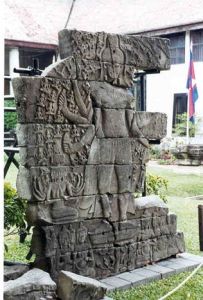

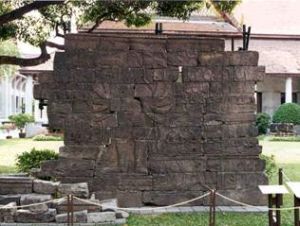
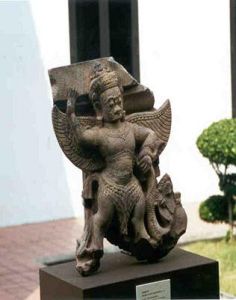
 Mac is still not very well but is still e-mailing strong. In this month’s Globetrotter e-newsletter, he writes about postcards he sent home over the years and a trip he made over twenty years ago to Britain’s Chelsea Pensioners.
Mac is still not very well but is still e-mailing strong. In this month’s Globetrotter e-newsletter, he writes about postcards he sent home over the years and a trip he made over twenty years ago to Britain’s Chelsea Pensioners.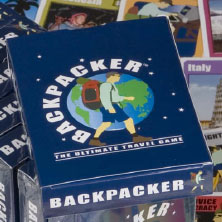 Backpacker – The Ultimate Travel Game is a card game in which you experience all the fun and unpredictability of travelling the world as you try to outwit your opponents to be the player who has returned home with the most photos. In Backpacker you visit different countries and continents, enjoy beaches, trekking, wildlife and culture, meet other travellers and get good and bad advice, whilst trying to avoid getting sick or missing your plane. You may even have to change your plans or seek assistance to cope with problems and delays, some of which may be caused by your fellow players. You need planning, good timing, patience and a bit of luck to win and with so many scenarios, no two games are ever the same. Just like travelling, it’s fun, exciting, fast-changing and very addictive.
Backpacker – The Ultimate Travel Game is a card game in which you experience all the fun and unpredictability of travelling the world as you try to outwit your opponents to be the player who has returned home with the most photos. In Backpacker you visit different countries and continents, enjoy beaches, trekking, wildlife and culture, meet other travellers and get good and bad advice, whilst trying to avoid getting sick or missing your plane. You may even have to change your plans or seek assistance to cope with problems and delays, some of which may be caused by your fellow players. You need planning, good timing, patience and a bit of luck to win and with so many scenarios, no two games are ever the same. Just like travelling, it’s fun, exciting, fast-changing and very addictive. In Kamakura, I visited the Bamboo temple that my Tokyo friend told me about, set in a grove of bamboo, with monks chanting and green tea served in the garden. After this, I visited the giant Buddha, which used to be in a building until a tsunami removed them.
In Kamakura, I visited the Bamboo temple that my Tokyo friend told me about, set in a grove of bamboo, with monks chanting and green tea served in the garden. After this, I visited the giant Buddha, which used to be in a building until a tsunami removed them.  From Kamakura, I went to Enoshima island which is near Kamakura. It takes about an hour on the train from Tokyo. Enoshima was fun and tried to do a geocache, but there were too many people about and too much rubbish around as well, so went back to Tokyo.
From Kamakura, I went to Enoshima island which is near Kamakura. It takes about an hour on the train from Tokyo. Enoshima was fun and tried to do a geocache, but there were too many people about and too much rubbish around as well, so went back to Tokyo. Another trip I made was taking the bus to Mt Zao, which despite being only 10 miles away took 90 mins to get to, thanks to the winding mountain roads and switchback hairpins. It was worth the ride to see Okama, a massive volcanic lake, fantastic place, you get to it via a chair lift. Loads of snow still, which you have to slip and slide through. Then walked up to Mt Kattadate over 5,000ft, spectacular views. Bought a mini bell for my rucksack. The Japanese all have them, they are to scare off bears!
Another trip I made was taking the bus to Mt Zao, which despite being only 10 miles away took 90 mins to get to, thanks to the winding mountain roads and switchback hairpins. It was worth the ride to see Okama, a massive volcanic lake, fantastic place, you get to it via a chair lift. Loads of snow still, which you have to slip and slide through. Then walked up to Mt Kattadate over 5,000ft, spectacular views. Bought a mini bell for my rucksack. The Japanese all have them, they are to scare off bears!  Eventually got the train to Hon Shiogama, this was in order to take the scenic boat trip to Matsushima (1400Yen). Nice 50 min ride through all the little islands, though absolutely freezing there and very windy.
Eventually got the train to Hon Shiogama, this was in order to take the scenic boat trip to Matsushima (1400Yen). Nice 50 min ride through all the little islands, though absolutely freezing there and very windy.  Ethnologists state that there are six broad hill tribe groupings: Karen, Lahu, Hmong, Lisu, Akha and Mien. Within these categories, there are sub-categories and clans that further divide the groups. Each hill tribe has its own customs, language, dress and spiritual beliefs and this is sometimes true even of the numerous sub-categories within one hill tribe. For example, the Green Hmong and White Hmong are said to speak in different and distinct dialects and dress differently.
Ethnologists state that there are six broad hill tribe groupings: Karen, Lahu, Hmong, Lisu, Akha and Mien. Within these categories, there are sub-categories and clans that further divide the groups. Each hill tribe has its own customs, language, dress and spiritual beliefs and this is sometimes true even of the numerous sub-categories within one hill tribe. For example, the Green Hmong and White Hmong are said to speak in different and distinct dialects and dress differently. 
 The main reason tourists come to visit the Paduang is because of the long-necked women. When the Beetle was in Thailand, she was told that the women in this tribe wore huge coils of metal around their necks to protect them from tigers. She asked if this tradition still held true and was assured that it did. What a load of nonsense! The women who wear these huge coils around their neck do so as a means of income generation from fees from tourists taking their photos and buying handicrafts presented at their stores. It came across, sadly, as something of a human freak show.
The main reason tourists come to visit the Paduang is because of the long-necked women. When the Beetle was in Thailand, she was told that the women in this tribe wore huge coils of metal around their necks to protect them from tigers. She asked if this tradition still held true and was assured that it did. What a load of nonsense! The women who wear these huge coils around their neck do so as a means of income generation from fees from tourists taking their photos and buying handicrafts presented at their stores. It came across, sadly, as something of a human freak show. down to the ankles.
down to the ankles. 